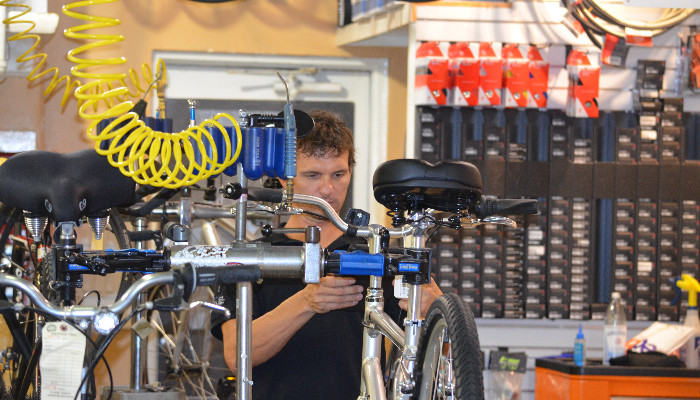As online shopping options multiply, local retailers are left fretting about the future.
By A.C. Shilton
Natalia Sandoval remembers it clearly: A local runner walked into her store wanting a full gait analysis. Sandoval was happy to oblige—service was what her fledgling business, 360 Degree Athlete, was all about. The two spent several hours together, with Sandoval grabbing shoe after shoe for the customer to try. Finally, they found it: the perfect pair.
But the client was gun-shy. At the end of the extensive consultation she told Sandoval, “I’m undecided, I’m not going to do anything today.”
A few weeks later, Sandoval saw the gal at a local race sporting the exact pair of kicks she’d so painstakingly fit to her feet. She hadn’t been back to 360 Degree Athlete; instead she’d bought them online. Sandoval had been “showroomed.”
Showrooming—which is now so commonplace that there’s a Wikipedia entry on the subject—is the practice of checking out a product in a brick-and-mortar retailer with no intention of actually buying it. Megastores like Target and BestBuy have been strongly affected by the practice in recent years—but so too have local retailers.
Running and cycling shops, which have notoriously low profit margins, especially struggle to compete. According to a 2013 Harris Poll report, apparel purchases are the second-most commonly “showroomed” item, behind only electronics.
And while that runner may have gotten a slightly better deal on her shoes by not buying from Sandoval, her actions may cost her in the long run.
Sure, a penny saved may be a penny earned, but if that penny saved puts all of our local running, cycling and sports retailers out of business, have we really earned something good? Here’s a look at who the real winners and losers are in the lowest-price-takes-all retail game.
RUNNING THIS TOWN
It’s bright and cool inside the impeccably organized Naples On The Run store. It smells like new rubber soles and the promise of faster times ahead. Manager Carl Egbert is in the back, re-arranging a few things when a teenage girl pops in.
She’s come straight from track practice, with the shoes she bought just the previous day swinging in her hands. “They’re too long,” she says, adding that she thinks her feet might have been swollen when she bought them. “I only wore them for our warm up,” she solemnly promises.
Egbert reaches over the counter and takes the shoes. She didn’t bring the box and there are obvious black scuffmarks from the track pockmarking the soles. Nonetheless, he hands her another slightly smaller pair—free of charge. As she bounces out the door he reminds her to try and bring the box back. Of course, there’s no way to know if he’ll ever see it again or not. The pair of shoes he’s left holding, one of his most popular models in one of the most popular sizes, is now all but unsellable.
Egbert explains that he’ll probably just have to write these shoes off as a loss, but that’s okay because he likes to support the local high school athlete.
By now, maybe you’re shaking your head, thinking Naples On The Run’s business model is too generous. However, it’s hard to imagine our area having the robust running scene it does without the store’s commitment to building the local running community. The tucked away little shop—which is completely intertwined with Gulf Coast Runners—hosts packet pickups for more than a dozen races a year. It supports the Gulf Coast Runner’s Youth Team and scholarship program. It gives discounts to local high school runners and collects shoes for the Guadalupe Center in Immokalee.
But Naples On The Run is hardly an anomaly. According to the Institute for Local Self Reliance, a non-profit think-tank that advocates for strengthening local economies, small businesses donate twice as much money per employee than their national chain counterparts. Additionally, these businesses donate money within their own communities, whereas national chains are often tied to nationwide corporate initiatives.
Locally and nationally, top athletes often come up through the ranks with the support of their local running store behind them. A great example is marathon phenom Desiree Davila. Nurtured by the Hanson-Brooks Distance Project, an offshoot of Hanson’s Running Shop in Michigan, Davilla represented the United States in the Marathon at the 2012 Olympic Games. While she’s a big-name success story, there are thousands, maybe more, of small-time athletes with big-time dreams leaning on their local running stores.
On a fundamental level, we need local running and biking retailers. We need them for when the puppy gets to our favorite pair of shoes the day before our marathon. We need them because we need a place to hangout and geek-out with like-minded people. We need them because they provide a locus around which our group rides and races can orbit.
We also need them, however, for our local economy. A 2002 Economic Impact Analysis conducted by the group Civic Economics traced money spent at both local and national chain booksellers in the same neighborhood in Austin, Texas. For each $100 spent at the local retailer, $45 was injected back into the local economy. For the national bookseller (which was Borders) $100 only translated to $13 staying in the local economy.
While national retailers do pay local salaries, they tend to be the low-level positions. Higher positions, along with things like accounting, marketing and web design, are usually handled at the corporate office. Local retailers, however, rely on a staff of local pros.
“We have a local accountant, on Marco Island,” says Peter Marsh, sales manager and co-owner of Naples Cyclery, “and our web stuff for our Fit & Fuel page is done locally too,” he adds. Naples on the Run also utilizes local bookkeepers and web developers.
The Austin study, which has since been replicated in several markets around the country, showed that one of the local merchants had a $4.1 million annual economic impact on the local community, whereas Borders had only a $.8 million annual economic impact. So while an individual book may have cost slightly more at the local retailer, the return on investment for the community was considerable.
THE ETHICS OF IT ALL
Paying more for the common good—isn’t that the antithesis of capitalism? Maybe, but there’s an ethical component here too. When you showroom a store, you’re technically stealing.
“I do consider it stealing,” says Sandoval. “I think people don’t understand that it’s your life; you’re putting everything into it.”
You’d never go to a dermatologist and walk away without paying for the consultation—even if you opted not to buy any of the office’s many wonder-creams. Somehow, however, it’s okay to do this to a retail store employee, even though many have spent thousands of their own dollars becoming certified to fit shoes or bikes to customers.
Beyond that, floor models tend to get damaged in the try-on process. While storeowners want you to get a good feel for the shoe you’re buying, every time the sole of that shoe hits the ground, it becomes slightly less sellable.
Add to all of this the fact that many manufacturers offer deep discounts based on volume—benefiting big-box stores that order by the million—and it’s easy to see a day when your local sporting good retailer is an endangered species.
There are, however, some bright spots. A few manufacturers—mostly in the bike industry—have made commitments to supporting independent dealers. Brands like Specialized, Trek and Giant all sell only to local dealers. A Specialized helmet purchased through Specialized’s online retail site is listed at MSRP—never any lower—and shipping isn’t free. Company founder and CEO Mike Sinyard even came out swinging last year against Amazon.com’s Price Check app. The free app allows customers to scan barcodes in store to check prices online—it’s a showrooming customer’s dream come true. In a letter to Bicycle Retailer and Industry News, Sinyard urged retailers to refuse to do business with those companies that utilized Amazon’s new app.
“…Who loses in this situation? Certainly not Amazon. And, at least in the short term, not the cycling brands selling through bike shops and Amazon. But what about you?
By buying product from brands that severely undercut you, you are supporting your competition. Why finance your own demise?…”
Peter Marsh, at Naples Cyclery, says that Specialized’s commitment to supporting independent dealers has truly allowed his shop to flourish. “It’s hard for me to carry a product when I know the vendor isn’t standing behind me,” he says.
Unfortunately for running stores, there’s no one standing behind them. For many years, Brooks Running Shoes was the only shoe company to sell only to specialty running retailers. While you could get Nikes or Adidas at Dick’s or Sports Authority, if you wanted Brooks, you’d have to find a local running store. But within the last year (still trying to get the exact date from Brooks), that’s changed.
Carl Egbert at Naples on the Run says that the company tried to make up for the shift by offering new models a few weeks earlier to local retails and making special, small-store-only colors.
“Brooks is our best seller, two to one,” says Egbert. “But now that it is there [in big box retailers] there’s competition that didn’t used to be there. It would be nice if they wouldn’t do it, but it’s not that they want to destroy local business, they just want to sell more shoes.”
But when all these factors—the higher vendor pricing, the ability to showroom on your smart phone and the ever rising cost of brick-and-mortar business—combine, it forms a pretty tough tidal wave of competition for local stores to swim against. Somewhere along the line, the current will inevitably tow someone under.
Locally, that person was Sandoval. Her store closed nine months ago. She’s now back at her old job, working as a branch manager at a bank.
“I’ve always loved running, my father was a marathoner, and I’d always wanted to open a store. For me, it was about the passion and the love for running. I want to run until I’m 90 and I wanted everyone else to feel like that,” says Sandoval. But it wasn’t to be. She adds, “I put my heart and soul into that store and as much as it hurt to close it, it was what I had to do. Unfortunately, I don’t think that small running shops are going to survive.”
Maybe that’s just the natural order of things, the cost of business evolution; another example of survival of the fittest. Except, ironically it’s not, because without local experts our bikes and our shoes won’t fit at all. Survival of the ill-fitting, perhaps.
And like a blister that forms after three miles into a marathon, we’ll technically be able to soldier through without them. Ultimately, though, we’ll be the ones left suffering.


